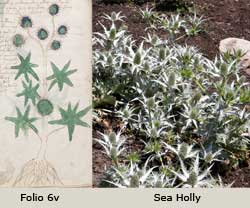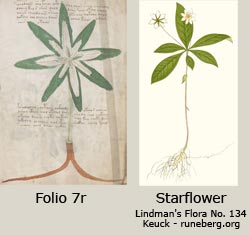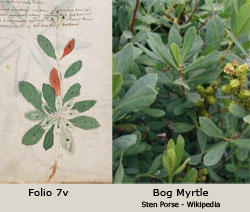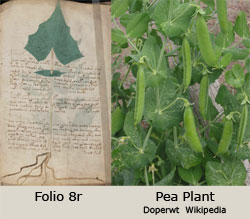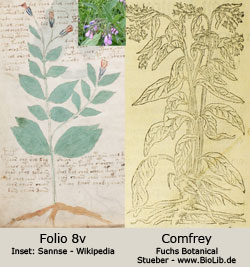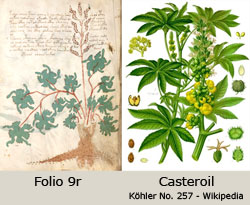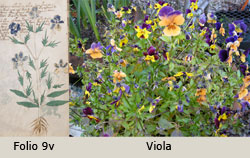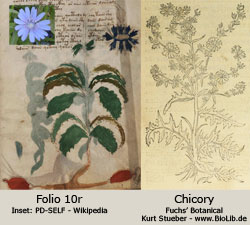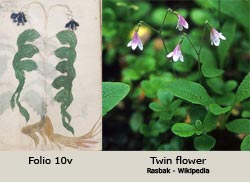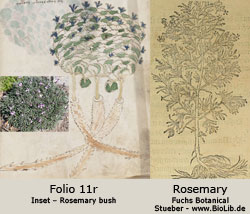The Voynich Botanical Plants
Folio 6v, Sea Holly (Eryngium maritimum), grows in coastal areas of Europe. It has a taproot; silvery, spiny-toothed leaves; and flowers surrounded by thistle-like bracts. The name Eryngium comes from the Greek word to cure indigestion. In medieval times sea holly was also used as an aphrodisiac.
Folio 7r, Starflower (Trientalis europaea), is a small woodland plant found in Northern Europe. It is a member of the primulaceae family and is on the endangered species list. The plant base has one or more whorls of teardrop shaped leaves that turn a copper hue in the late summer. The small white flowers usually have 6-8 petals. There is a drawing of a star flower (8 petals) in the right hand top corner of Leonardo da Vinci’s drawing of the Star of Bethleham (6 petals). The plant was used in an ointment for treating wounds.
Folio 7v, Bog Myrtle (Myrica gale), is native to Western Europe. The finely-serrated, simple leaves are arranged in a spiral along the stem; the flowers are catkins, with male and female catkins on separate plants; the fruit is a small drupe. Prior to the 16th century, the leaves were used to flavor beer, later being replaced with hops. The foliage has been used as an insect repellent and, by tradition, it is part of Royal Wedding bouquets.
Folio 8r, Green Pea (Pisum sativum), is an annual Eurasian vine of the legume family that is grown for its protein-rich seeds. Cultivation of pea plants spread from the Middle East into Europe during Neolithic times. The pea is an annual, cool-season crop. Each leaf has a branched tendril at its tip and one to three pairs of leaflets. The flowers are white or purple and the mature pea pod contains 3-9 seeds. Mendel used green pea plants to establish his laws of inheritance and formulated the basic principles of modern genetics.
Folio 8v, Comfrey (Symphytum officinale L.), grows in damp meadows in Europe. It has a black, turnip-like root and large, hairy, broad leaves that decrease in size the higher they grow up the stem. The stem ends in a cluster of small, bell-shaped, purple flowers. Due to the presence of steroidal saponins and mucilage in comfrey, the root and leaves were useful in treating a wide variety of ailments ranging from bronchial problems, broken bones, sprains, arthritis, gastric and varicose ulcers, severe burns, and acne and other skin conditions.
Folio 9r, Casteroil (Ricinus communis), is a suckering, perennial shrub native to the Eastern and Southeastern Africa. About 6,000 years ago the plant spread from Egypt to the Mediterranean, the Middle East, and India. The leaves of casteroil are attached by the center of the leaf blade to reddish purple stems (vet.purdue.edu). It has very toxic seeds which are used to produce a nonedible oil. Casteroil seeds have been found in Egyptian tombs and the Greeks used the oil from casteroil seeds to anoint their bodies. Castoroil is used as a purgative.
Folio 9v, Viola (Violaceae), was identified by Dana Scott (Kennedy G. and Churchill R, 2004, The Voynich Manuscript, Inner Traditions, Vermont, p.164). This plant is native to the more temperate regions of the Northern hemisphere. All parts of the plant are edible being rich in vitamins A and C. The flowers are used as an herbal tea and as decorations for cakes.
Folio 10r, Chicory or Endive (Cichorium pumilum), is a bushy, perennial herb with blue or lavender flowers. It originated in the countries around the Mediterranean Sea. The Romans used chicory in their recipes and Horace stated: “As for me, olives, endives, and mallows provide sustenance.” Today the leaves are used in salads and the parsnip-like roots are cooked for a vegetable or dried and used as a coffee substitute.
Folio 10v, Twinflower (Linnaea borealis), is found in cool temperate forests of Europe, Asia and North America. This small plant has slender stems with opposite, evergreen oval leaves (the leaves of the plant 10v are very long), the flowers are paired, pendulous, and pale pink with a five-lobed corolla. This was Linnaeus’ favorite plant—it was named after him and he took the flower as his personal symbol when he was raised to the Swedish nobility in 1757.
Folio 11r, Rosemary (Rosmarinus officinalis), is an evergreen, woody, upright or sprawling, perennial herb native to the Mediterranean region. It has a taproot; small, blue flowers; and thin, spiky, evergreen leaves with a pungent aromatic odor, that are used to flavor a wide variety of Mediterranean foods. Rosemary can be propagated either by seeds, layering of branches, or division of roots. The ancients used rosemary to improve memory and it was also used as a symbol of remembrance at funerals and weddings. Orphelia reminds us: “rosemary is for rememberance.”
